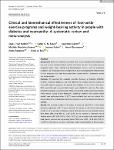Clinical and biomechanical effectiveness of foot‐ankle exercise programs and weight‐bearing activity in people with diabetes and neuropathy: A systematic review and meta‐analysis
| dc.contributor.author | van Netten, JJ | |
| dc.contributor.author | Sacco, ICN | |
| dc.contributor.author | Lavery, L | |
| dc.contributor.author | Monteiro‐Soares, M | |
| dc.contributor.author | Paton, J | |
| dc.contributor.author | Rasmussen, A | |
| dc.contributor.author | Raspovic, A | |
| dc.contributor.author | Bus, SA | |
| dc.date.accessioned | 2023-10-12T16:44:33Z | |
| dc.date.available | 2023-10-12T16:44:33Z | |
| dc.date.issued | 2023-05-02 | |
| dc.identifier.issn | 1520-7552 | |
| dc.identifier.issn | 1520-7560 | |
| dc.identifier.uri | https://pearl.plymouth.ac.uk/handle/10026.1/21407 | |
| dc.description.abstract |
Background. Most interventions to prevent foot ulcers in people with diabetes do not seek to reverse the foot abnormalities that led to the ulcer. Foot‐ankle exercise programs target these clinical and biomechanical factors, such as protective sensation and mechanical stress. Multiple RCTs exist investigating the effectiveness of such programs, but these have never been summarised in a systematic review and meta‐analysis. Methods. We searched the available scientific literature in PubMed, EMBASE, CINAHL, Cochrane databases and trial registries for original research studies on foot‐ankle exercise programs for people with diabetes at risk of foot ulceration. Both controlled and non‐controlled studies were eligible for selection. Two independent reviewers assessed the risk of bias of controlled studies and extracted data. Meta‐analysis (using Mantel‐Haenszel's statistical method and random effect models) was performed when >2 RCTs were available that met our criteria. Evidence statements, including the certainty of evidence, were formulated according to GRADE. Results. We included a total of 29 studies, of which 16 were RCTs. A foot‐ankle exercise programme of 8–12 weeks duration for people at risk of foot ulceration results in: (a) no increase or decrease risk of foot ulceration or pre‐ulcerative lesion (Risk Ratio (RR): 0.56 (95% CI: 0.20–1.57)); (b) no increase or decrease risk of adverse events (RR: 1.04 (95% CI: 0.65–1.67)); (c) not increase or decrease barefoot peak plantar pressure during walking (Mean Difference (MD): −6.28 kPa (95% CI: −69.90–57.34)); (d) no increase or decrease health‐related quality of life (no meta‐analysis possible). Likely results in increases in ankle joint and first metatarsalphalangeal joint range of motion (MD: 1.49° (95% CI: −0.28–3.26)) may result in improvements in neuropathy signs and symptoms (MD: −1.42 (95% CI: −2.95‐0.12)), may result in a small increase in daily steps in some people (MD: 131 steps (95% CI: ‐492‐754)), and may not increase or decrease foot and ankle muscle strength and function (no meta‐analysis was possible). Conclusions. In people at risk of foot ulceration, a foot‐ankle exercise programme of 8–12 weeks duration may not prevent or cause diabetes‐related foot ulceration. However, such a programme likely improves the ankle joint and first metatarsalphalangeal joint range of motion and neuropathy signs and symptoms. Further research is needed to strengthen the evidence base, and should also focus on the effects of specific components of foot‐ankle exercise programs. | |
| dc.format.extent | e3649- | |
| dc.format.medium | Print-Electronic | |
| dc.language | en | |
| dc.publisher | Wiley | |
| dc.subject | diabetes mellitus | |
| dc.subject | diabetic foot | |
| dc.subject | diabetic neuropathies | |
| dc.subject | exercise | |
| dc.subject | foot ulcer | |
| dc.subject | prevention | |
| dc.title | Clinical and biomechanical effectiveness of foot‐ankle exercise programs and weight‐bearing activity in people with diabetes and neuropathy: A systematic review and meta‐analysis | |
| dc.type | journal-article | |
| dc.type | Review | |
| dc.type | Early Access | |
| plymouth.author-url | https://www.ncbi.nlm.nih.gov/pubmed/37132203 | |
| plymouth.issue | 3 | |
| plymouth.volume | 40 | |
| plymouth.publication-status | Published online | |
| plymouth.journal | Diabetes/Metabolism Research and Reviews | |
| dc.identifier.doi | 10.1002/dmrr.3649 | |
| plymouth.organisational-group | |Plymouth | |
| plymouth.organisational-group | |Plymouth|Research Groups | |
| plymouth.organisational-group | |Plymouth|Faculty of Health | |
| plymouth.organisational-group | |Plymouth|Faculty of Health|School of Health Professions | |
| plymouth.organisational-group | |Plymouth|Research Groups|Institute of Health and Community | |
| plymouth.organisational-group | |Plymouth|REF 2021 Researchers by UoA | |
| plymouth.organisational-group | |Plymouth|Users by role | |
| plymouth.organisational-group | |Plymouth|Users by role|Academics | |
| plymouth.organisational-group | |Plymouth|REF 2021 Researchers by UoA|UoA03 Allied Health Professions, Dentistry, Nursing and Pharmacy | |
| plymouth.organisational-group | |Plymouth|Users by role|Researchers in ResearchFish submission | |
| dc.publisher.place | England | |
| dcterms.dateAccepted | 2023-04-17 | |
| dc.date.updated | 2023-10-12T16:44:14Z | |
| dc.rights.embargodate | 2023-10-13 | |
| dc.identifier.eissn | 1520-7560 | |
| dc.rights.embargoperiod | forever | |
| rioxxterms.versionofrecord | 10.1002/dmrr.3649 |


